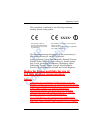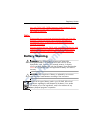
A–10 User’s Guide
Regulatory Notices
Singaporean Wireless Notice
■ Switch off your cellular telephone when in an aircraft. The
use of cellular telephones in an aircraft may be dangerous to
the operation of the aircraft, disrupt the cellular network, and
is illegal. Failure to observe this instruction may lead to
suspension or denial of cellular services to the offender, or
legal action or both.
■ Users are advised not to use the equipment when at a
refueling point.
■ Users are reminded of the need to observe restrictions on the
use of radio equipment in fuel depots, chemical plants or
where blasting operations are in progress.
■ The use of the Alert device to operate a vehicle’s lights or
horn on public roads is not permitted.
■ It is advised that a handheld microphone or telephone handset
should not be used by the driver while the vehicle is moving,
except in an emergency. Speak only into a fixed, neck slung
or clipped-on microphone when it would not distract your
attention from the road.
■ As with other mobile radio transmitting equipment, users are
advised that for satisfactory operation of the equipment and
for the safety of personnel, it is recommended that no part of
the human body be allowed to come too close to the antenna
during operation of the equipment.
■ This device has been designed to comply with applicable
requirements for exposure to radio waves based on scientific
guidelines that include margins intended to assure the safety
of all people, regardless of health and age. These radio wave
exposure guidelines employ a unit of measurement known as
the Specific Absorption Rate (SAR). Tests for SAR are
conducted using standardized methods with the phone
transmitting at its highest certified power level in all used
frequency bands. The SAR data information is based on
CENELEC’s standards EN50360 and EN50361 which use
HP
Confidential


















